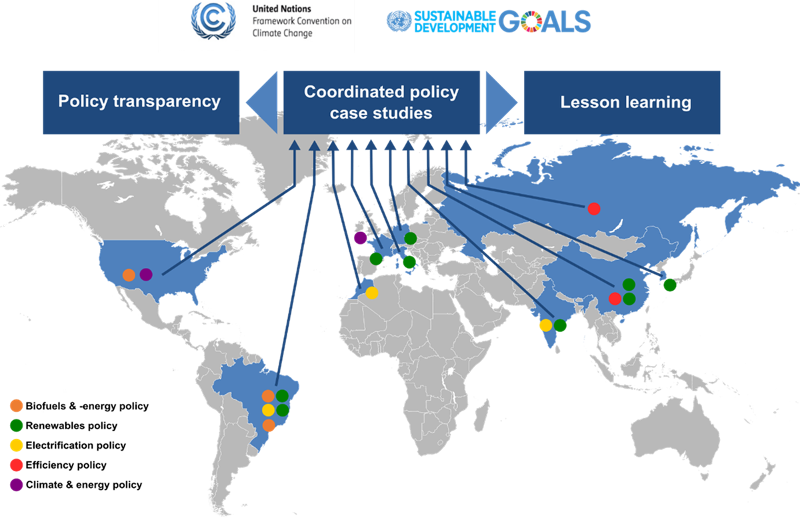
Policy Brief #22, June 2019. A study of seventeen climate and energy policies offers design guidelines for more effective policymaking and implementation.
- A fundamental shift in how policies are designed, monitored, and governed is needed if the multiple challenges of energy, sustainability, and climate-change are to be addressed within tight time-frames.
- Three design principles are essential to successful multi-goal policy: Complementarity, transparency, and adaptability.
- Understanding interactions and synergies among objectives is critical but requires additional analysis and input from the science community.
- All objectives within a multiple-objective policy need to be adopted as official policy then rigorously pursued and monitored.
- Policy objectives need to be explicit, rather than merely implicit. They also demand that synergies and tradeoffs between different objectives are accounted for. This may require prioritizing and weighing among objectives and understanding that those objectives may shift over time. Dedicated policy features clearly linked to specific additional objectives are required.
- There is a need to rethink policy processes along with institutional and governance arrangements in order to facilitate more coordination. In cases where original objectives are no longer feasible then policy re-design is crucial. The process for achieving this should be built-in as the policy is designed.
- Coordinated and comprehensive policies are the only means of achieving the United Nation’s Sustainable Development Goals (SDGs) and the Paris Agreement’s goals.
A study of seventeen climate and energy policies - many of them national flagship programs - offers design guidelines for more effective policymaking and implementation. The benefit to be gained from better policy is clear: more rapid progress toward the objectives of the 2015 Paris Agreement and the United Nation’s SDGs.
In all cases studied, policies were driven by both climate and development concerns. Such policies can be challenging to design, implement, and monitor because of the requirement for coordination across sectors and implementing agencies.
Poor policy design can lead to a single dominant objective working to the disadvantage of other objectives. Often that dominant objective is linked to the agency tasked with its execution, e.g. an energy ministry which has little expertise in climate or development might fail to adequately meet additional goals.
IIASA researchers and colleagues from other institutions found that adhering to specific design principles can lead to more effective multiple-objective policies which deliver timely and desirable results. Current government organisational systems often act as a barrier to implementation, e.g. ministries working in silos with poor collaboration between different sectors and institutions. Opportunities for effective ways to promote progress towards additional policy goals are often missed.
Background
There is no easy path to the targets set out in the Paris Agreement or the SDGs, but this study indicates that poor policy design and implementation is making the path longer and more difficult than it need be. Governments are correctly applying well founded science and technology to policy and target setting but failing to hit those multiple targets through lack of experience with multiple-objective policy design.
In most cases studied, a single objective dominates, often a core goal of the agency tasked with its execution. Other objectives are often only reflected in an implicit way, for instance, as a nice-to-have addition. Collaboration between different ministries, institutions, layers of bureaucracy, and industry are often not explicitly written into a policy. Trade-offs between different goals are rarely considered. The conclusion is that not just one dominant objective, but all policy objectives must be rigorously pursued and monitored while applying three major design principles.
Multiple objective policies can succeed or fail
Policies deploying renewable energy often seek synergies with industry to create employment and grow economies. These are classic multiple-objective policies which aim to simultaneously yield environmental and socioeconomic benefits. Case studies reveal that design factors will strongly influence the degree to which such policies succeed. As an example, South Korea’s renewable energy policy also aimed to develop renewable technologies into competitive industries, thus creating wealth while addressing climate change concerns, a laudable policy. However, the policy neglected to include industrial policy elements which eventually resulted in limited growth of the country’s renewable energy industrial base.
In the case of China’s Green Lights Program the outcome was much closer to the original policy targets. An energy efficiency program was closely linked with industrial development objectives. This created the essential technological foundations for China’s domestic efficient lighting industry (Guo & Pachauri 2017). In summary, the program achieved its primary objective of electricity savings while establishing a globally competitive efficient lighting industry to meet growing domestic demand and exports. So what are the lessons for future policy design? First and foremost, the implementation of a decision-design process is necessary in which objectives are weighted against each other and policies are designed to maximize total benefits across all of them.
Important multiple-objective policy elements
- Explicit identification of objectives
- Explicit analysis of interactions among objectives
- Weighting of objectives
- Clear communication and management of expectations
- A broad and transparent set of indicators for monitoring and evaluation
- Use of sound and comprehensive data
Three design features essential to successful multiple-objective policy
Complementarity: Balancing multiple objectives
Complementarity involves a significant shift from the traditional single objective view of policy making. It addresses the prevailing misconception in policy design that a single instrument is sufficient to achieve simultaneous multiple objectives. It requires that specific additional objectives are woven into complementary policies in a way which balances impacts and achieves objectives other than the primary one.
Adaptability: Policy reacting to change
Think about policies as a sequence of measures with contingency plans ready for deployment as objectives change. Thus policies must be durable but adaptable. When original objectives turn out to be unachievable, reform and policy re-design is crucial to align it with the changed objectives. This has implications for monitoring systems: Can the policy react to new government priorities, evolving energy systems, or new technologies? Changing market conditions have also been shown to severely impact policy outcomes.
Transparency: Track impacts across all objectives
If synergies and trade-offs change over time then transparency is essential to ensure the right policy reform. As an example, Brazil’s biodiesel policy included a social inclusion target designed to benefit small landholders. However independent evaluations concluded the government used unreliable data and that the policy failed to achieve social inclusion targets. Institutionalised and inclusive evaluation will facilitate policy success.
Acknowledgments
The research leading to these results has received funding from the European Union’s Horizon 2020 research and innovation program under Grant agreement No 642147 (CD-LINKS).
IIASA Policy Briefs present the latest research for policymakers from IIASA - an international, interdisciplinary research institute with National Member Organizations (NMOs) in countries in Africa, the Americas, Asia, and Europe. The views expressed herein are those of the researchers and not necessarily those of IIASA or its NMOs.

